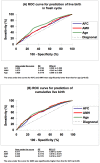Role of baseline antral follicle count and anti-Mullerian hormone in prediction of cumulative live birth in the first in vitro fertilisation cycle: a retrospective cohort analysis
- PMID: 23637787
- PMCID: PMC3634063
- DOI: 10.1371/journal.pone.0061095
Role of baseline antral follicle count and anti-Mullerian hormone in prediction of cumulative live birth in the first in vitro fertilisation cycle: a retrospective cohort analysis
Abstract
Objective: This retrospective study determined for the first time the role of baseline antral follicle count (AFC) and serum anti-Mullerian hormone (AMH) level in the first in-vitro fertilisation (IVF) cycle in predicting cumulative live birth from one stimulation cycle.
Methods: We studied 1,156 women (median age 35 years) undergoing the first IVF cycle. Baseline AFC and AMH level on the day before ovarian stimulation were analysed. The main outcome measure was cumulative live birth in the fresh plus all the frozen embryo transfers after the same stimulation cycle.
Results: Serum AMH was significantly correlated with AFC. Both AMH and AFC showed significant correlation with age and ovarian response in the stimulated cycle and total number of transferrable embryos. Baseline AFC and serum AMH were significantly higher in subjects attaining a live birth than those who did not in the fresh stimulated cycle, as well as those attaining cumulative live birth. There was a significant trend of higher cumulative live birth rate in women with higher AMH or AFC. However, logistic regression revealed that both AMH and AFC were not significant predictors of cumulative live birth after adjusting for age and number of embryos available for transfer. Considering only one single predictor, the areas under the ROC curves for AMH (0.646, 95% CI 0.616-0.675) and age (0.648, 95% CI 0.618-0.677) were slightly higher than that for AFC (0.617, 95% CI 0.587-0.647) in predicting cumulative live birth. However, a model combining AMH (with or without AFC) and age of the women only classified an addition of less than 2% of subjects correctly compared to the model with age alone.
Conclusion: Baseline AFC and serum AMH have only modest predictive performance on the occurrence of cumulative live birth, and may not give additional value on top of the women's age.
Conflict of interest statement
Figures


Similar articles
-
Role of baseline antral follicle count and anti-Mullerian hormone in the index stimulation cycle of IVF treatment in predicting outcome of subsequent frozen-thawed embryo transfers.Gynecol Endocrinol. 2014 Jul;30(7):490-3. doi: 10.3109/09513590.2014.899572. Epub 2014 Mar 18. Gynecol Endocrinol. 2014. PMID: 24641676
-
Ovarian response and cumulative live birth rate of women undergoing in-vitro fertilisation who had discordant anti-Mullerian hormone and antral follicle count measurements: a retrospective study.PLoS One. 2014 Oct 14;9(10):e108493. doi: 10.1371/journal.pone.0108493. eCollection 2014. PLoS One. 2014. PMID: 25313856 Free PMC article.
-
Predictive value of antral follicle count and serum anti-Müllerian hormone: Which is better for live birth prediction in patients aged over 40 with their first IVF treatment?Eur J Obstet Gynecol Reprod Biol. 2018 Feb;221:151-155. doi: 10.1016/j.ejogrb.2017.12.047. Epub 2017 Dec 29. Eur J Obstet Gynecol Reprod Biol. 2018. PMID: 29306180
-
Technical and performance characteristics of anti-Müllerian hormone and antral follicle count as biomarkers of ovarian response.Hum Reprod Update. 2015 Nov-Dec;21(6):698-710. doi: 10.1093/humupd/dmu062. Epub 2014 Dec 8. Hum Reprod Update. 2015. PMID: 25489055 Review.
-
Assessing ovarian response: antral follicle count versus anti-Müllerian hormone.Reprod Biomed Online. 2015 Oct;31(4):486-96. doi: 10.1016/j.rbmo.2015.06.015. Epub 2015 Jul 3. Reprod Biomed Online. 2015. PMID: 26283017 Review.
Cited by
-
Follicular output rate tends to improve clinical pregnancy outcomes in patients with polycystic ovary syndrome undergoing in vitro fertilization-embryo transfer treatment.J Int Med Res. 2019 Oct;47(10):5146-5154. doi: 10.1177/0300060519860680. Epub 2019 Aug 4. J Int Med Res. 2019. PMID: 31379237 Free PMC article.
-
Analysis of cumulative outcomes and influencing factors of patients with discrepancies between age and AMH levels in the early follicular phase prolonged protocol.Front Endocrinol (Lausanne). 2023 Mar 8;14:1098131. doi: 10.3389/fendo.2023.1098131. eCollection 2023. Front Endocrinol (Lausanne). 2023. PMID: 36967754 Free PMC article.
-
Clinical Application of AMH Measurement in Assisted Reproduction.Front Endocrinol (Lausanne). 2020 Dec 9;11:606744. doi: 10.3389/fendo.2020.606744. eCollection 2020. Front Endocrinol (Lausanne). 2020. PMID: 33362720 Free PMC article. Review.
-
Live birth and cumulative live birth rates in expected poor ovarian responders defined by the Bologna criteria following IVF/ICSI treatment.PLoS One. 2015 Mar 6;10(3):e0119149. doi: 10.1371/journal.pone.0119149. eCollection 2015. PLoS One. 2015. PMID: 25748478 Free PMC article. Clinical Trial.
-
Comparison of the prevalence and severity of nausea and vomiting in the first trimester between singleton pregnancies conceived from stimulated in vitro fertilization and frozen embryo transfer cycles.BMC Pregnancy Childbirth. 2022 Oct 4;22(1):746. doi: 10.1186/s12884-022-05072-5. BMC Pregnancy Childbirth. 2022. PMID: 36195858 Free PMC article.
References
-
- Nelson SM, Yates RW, Fleming R (2007) Serum anti-Mullerian hormone and FSH: prediction of live birth and extremes of response in stimulated cycles-implications for individualization of therapy. Hum Reprod 22(9): 2414–2421. - PubMed
-
- Nelson SM, Anderson RA, Broekmans FJ, Raine-Fenning N, Fleming R, et al. (2012) Anti-Mullerian hormone: clairvoyance or crystal clear? Hum Reprod 27(3): 631–636. - PubMed
-
- Broekmans FJ, Kwee J, Hendriks DJ, Mol BW, Lambalk CB (2006) A systematic review of tests predicting ovarian reserve and IVF outcome. Hum Reprod Update 12: 685–718. - PubMed
-
- Broer SL, Mol BWJ, Hendriks D, Broekmans FJM (2009) The role of antimullerian hormone in prediction of outcome after IVF: comparison with the antral follicle count. Fertil Steril 91(3): 705–714. - PubMed
-
- Broer SL, Dolleman M, Opmeer BC, Fauser BC, Mol BW, et al. (2011) AMH and AFC as predictors of excessive response in controlled ovarian hyperstimulation: a meta-analysis. Hum Reprod Update 17(1): 46–54. - PubMed
Publication types
MeSH terms
Substances
LinkOut - more resources
Full Text Sources
Other Literature Sources

